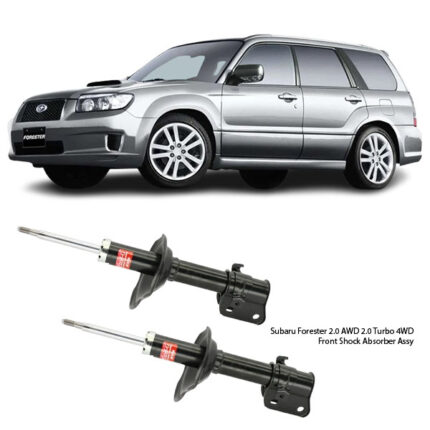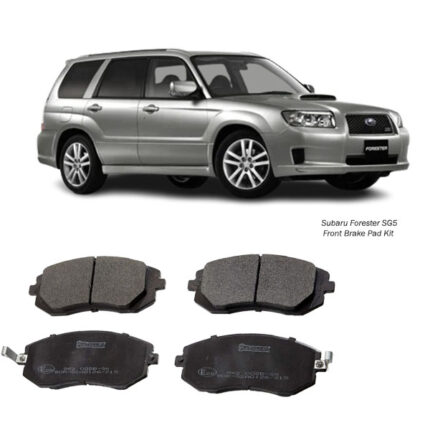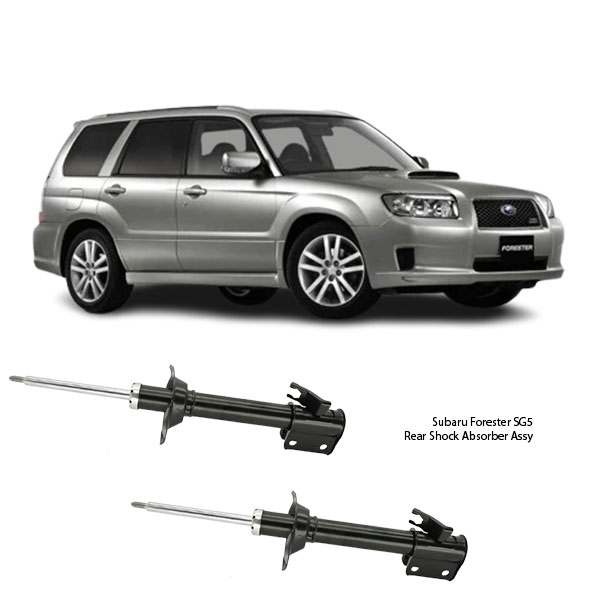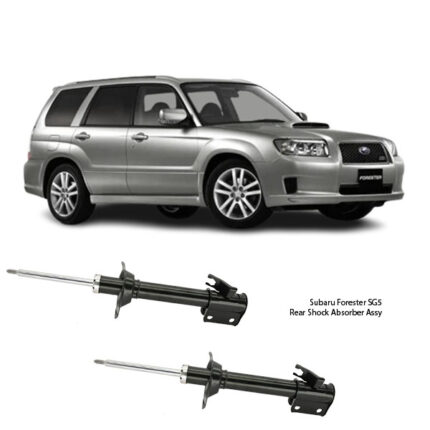Get Subaru Forester SG5 Rear Shock Absorber Assy 334344 in Kenya
The Rear Shock Absorber Assembly is a vital part of a vehicle’s suspension system, specifically engineered to control the movement of the rear wheels. Whether you’re navigating potholes, turning corners, or driving over uneven terrain, this component plays a major role in maintaining ride quality, road stability, and vehicle control. Though it often operates silently and without notice, the rear shock absorber assembly is fundamental to both safety and comfort on the road.
What Is a Rear Shock Absorber Assembly?
A rear shock absorber assembly is a hydraulic or gas-charged device designed to control unwanted motion in the rear suspension. It’s usually installed between the vehicle’s frame or body and the rear axle. The assembly includes a cylindrical damper (shock absorber), bushings or mounting hardware, and in some setups, a coil spring integrated around the shock—commonly referred to as a coilover design.
Shock absorbers are not meant to carry vehicle weight (that’s the job of springs); rather, they control the rate at which weight is transferred during motion—like braking, acceleration, and cornering.
Purpose and Function
The primary function of the rear shock absorber assembly is damping—reducing the oscillations of the suspension system. When the vehicle hits a bump, the springs compress to absorb the impact. Once the bump is passed, the springs rebound. Without shock absorbers, this bounce would continue uncontrollably, making the ride harsh and unstable. The rear shocks manage this motion and bring the vehicle back to a settled position quickly and smoothly.
Key functions include:
-
Dampening vibrations and movement
-
Maintaining consistent tire-road contact
-
Reducing sway and bounce at the rear
-
Preventing rear-end squat during acceleration
-
Improving overall handling and control
Components of the Rear Shock Absorber Assembly
-
Shock Body: The outer casing containing fluid and moving parts.
-
Piston and Rod: Moves through the fluid to create resistance.
-
Valving System: Controls fluid flow and thus the damping characteristics.
-
Seals and Bushings: Prevent leaks and reduce metal-to-metal contact.
-
Mounts: Secure the shock absorber to the frame and axle.
In some assemblies, the coil spring surrounds the shock (coilover setup), offering additional support and space-saving advantages.
Advantages of a High-Quality Rear Shock Absorber
-
Superior Ride Comfort: Quality shock absorbers effectively smooth out road imperfections, ensuring passengers at the back experience fewer jolts.
-
Enhanced Stability: Reduces swaying and bouncing, especially under heavy loads or during high-speed maneuvers.
-
Better Traction: Keeps the tires planted on the road surface, improving grip and braking performance.
-
Increased Lifespan of Other Components: Proper damping reduces stress on suspension arms, springs, tires, and chassis.
-
Noise Reduction: Minimizes knocking, rattling, or squeaking sounds often associated with worn components.
Disadvantages of a Worn or Low-Quality Rear Shock Absorber
A failing or substandard rear shock absorber can negatively impact vehicle performance in various ways:
-
Unstable Handling: Rear sway during turns or sudden maneuvers becomes more noticeable.
-
Increased Braking Distance: Poor shock damping can reduce tire contact with the road.
-
Premature Tire Wear: Tires can develop irregular wear patterns (e.g., cupping) due to inconsistent contact with the road.
-
Ride Discomfort: Bouncing or bottoming out over speed bumps and potholes.
-
Rear-End Squat: Excessive dipping or squatting at the back when accelerating.
-
Noisy Suspension: Clunking or banging noises from the rear, especially on rough roads.
Signs of a Failing Rear Shock Absorber
Recognizing symptoms early can prevent more serious damage and ensure safe driving. Common signs of worn rear shocks include:
-
Bouncing: The rear of the car continues to bounce after hitting a bump.
-
Visible Fluid Leaks: Oily residue or leakage on the shock body.
-
Uneven Rear Tire Wear: Especially cupping or scalloping of tread.
-
Poor Rear Grip: Rear wheels may slip on wet or uneven surfaces.
-
Noisy Ride: Rattles or knocking sounds from the rear suspension.
-
Increased Stopping Distance: Reduced road contact decreases braking efficiency.
-
Body Roll and Sway: Excessive lean when turning corners or switching lanes.
Types of Rear Shock Absorbers
-
Twin-Tube: Most common. Consists of an inner and outer tube. Cost-effective and reliable for general use.
-
Mono-Tube: Uses a single tube and offers better heat dissipation and faster response—ideal for performance or off-road applications.
-
Gas-Charged: Includes pressurized nitrogen to prevent oil foaming, ensuring consistent performance.
-
Coilover Shocks: Integrated spring and shock design. Offers better adjustability and load handling.
-
Electronic or Adaptive Shocks: Found in modern vehicles with adaptive suspension systems. Automatically adjust damping based on driving conditions.
Replacement and Maintenance
Most manufacturers recommend inspecting shocks every 20,000–30,000 km and replacing them at 80,000–100,000 km, depending on use and road conditions.
Steps to Replace Rear Shock Absorbers:
-
Lift the Vehicle: Use a hydraulic jack and secure it with stands.
-
Remove Rear Wheels: Gives access to the shock mounting bolts.
-
Unbolt the Old Shock: Remove both top and bottom mounting bolts.
-
Inspect Mounts and Bushings: Replace if worn or cracked.
-
Install the New Shock: Ensure proper alignment and torque to manufacturer specifications.
-
Reinstall Wheels and Lower: Check ride height and test on the road.
Always replace both rear shocks at the same time for balanced suspension response.
Rear Shocks vs. Rear Struts
Though similar in appearance and function, rear struts and shock absorbers are different components:
-
Shock Absorbers: Dampen motion only. They do not support the vehicle’s weight or alignment.
-
Struts: A structural component that integrates the shock with a coil spring and sometimes the steering knuckle. Struts help maintain wheel alignment and bear load.
Most vehicles use shock absorbers at the rear and struts at the front, but this varies based on design.
Follow us on Facebook for more parts.




